The Boston Theatre was a theatre in Boston, Massachusetts. It was first built in 1854 and operated as a theatre until 1925. Productions included performances by Thurlow Bergen, Charles A. Bigelow, Edwin Booth, Anna Held, James O'Neill Jennie Kimball, and others.
The Hollis Street Theatre (1885–1935) was a theatre in Boston, Massachusetts, that presented dramatic plays, opera, musical concerts, and other entertainments.

Samuel J. F. Thayer (1842–1893) was an American architect, notable for designing buildings such as the Providence City Hall and the Cathedral of St. George, as well as the town halls of Brookline, Stoughton, and Methuen, Massachusetts.
Amory Hall was located on the corner of Washington Street and West Street in Boston, Massachusetts, in the 19th century. Myriad activities took place in the rental hall, including sermons; lectures by Henry David Thoreau, Ralph Waldo Emerson, William Lloyd Garrison; political meetings; exhibitions by Rembrandt Peale, George Catlin, John Banvard; moving panoramas; magic shows; concerts; and curiosities such as the "Nova Scotia Giant Boy."

The Credit Valley Railway was a railway located in Ontario, Canada from Toronto to St. Thomas. Chartered in 1871 by Ontario railway magnate George Laidlaw, it operated as an independent company until 1883 when it was leased by the Ontario and Quebec Railway, a Canadian Pacific Railway (CPR) operating company building a network of lines in southern Ontario.
The Park Theatre (est.1879) was a playhouse in Boston, Massachusetts, in the late 19th and early 20th centuries. It later became the State cinema. Located on Washington Street, near Boylston Street, the building existed until 1990.
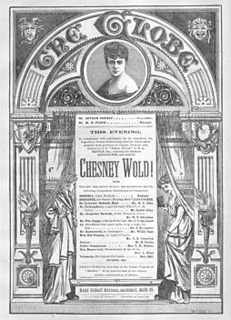
The Globe Theatre (est.1871) was a playhouse in Boston, Massachusetts, in the 19th century. It was located at 598 Washington Street, near the corner of Essex Street. Arthur Cheney oversaw the Globe until 1876. From 1871-1873 it occupied the former theatre of John H. Selwyn. After a fire in May 1873, the Globe re-opened on the same site in December 1874. Architect Benjamin F. Dwight designed the new building. From 1877-1893 John Stetson served as proprietor; some regarded him as "a theatrical producer with a reputation for illiteracy in his day such as Samuel Goldwyn has achieved" in the 1960s. The theatre burned down in January 1894.
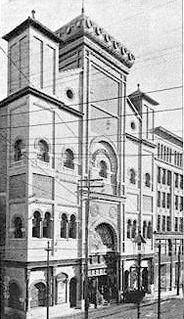
The Columbia Theatre (1891-ca.1957) or Loew's New Columbia Theatre in Boston, Massachusetts, was a playhouse and cinema located in the South End at no.978 Washington Street. Charles Frohman, Isaac Baker Rich and William Harris oversaw the theatre until 1895. Owners included J.J. Grace of New York and Loews. Staff included Harry Farren, Saul Hamilburg and Philip Shea. The Columbia existed until its demolition in 1957.
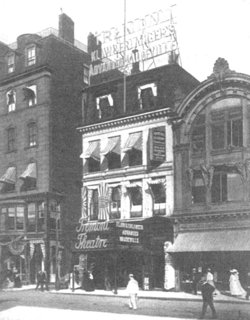
The Tremont Theatre was a playhouse in Boston, Massachusetts, in the late 19th and early 20th centuries. Henry E. Abbey and John B. Schoeffel established the enterprise and oversaw construction of its building at no.176 Tremont Street in the Boston Theater District area. Managers included Abbey, Schoeffel and Grau, Klaw & Erlanger, Thos. B. Lothan and Albert M. Sheehan.
The Grand Opera House (est.1888) of Boston, Massachusetts, was a theatre in the South End. Architect George Snell designed the 2,600-seat building on Washington Street. Managers and proprietors included Proctor & Mansfield, A.H. Dexter, George W. Magee, and Stair & Wilbur. Performances included Glyn's Three Weeks.
Chickering Hall (est.1883) was a concert auditorium in Boston, Massachusetts, in the late 19th century. It occupied the second floor of Chickering and Sons showrooms on Tremont Street, near the corner of West Street. "Bradlee, Winslow and Wetherell were the architects, and Mr. E.P. Treadwell, the decorator. The hall [was] lighted by the Edison electric light." By 1895: "Tremont St., towards Boylston, for some years has been called Piano Row, for a long row of piano agencies occupied a good portion of the block; but of late most of these have migrated to Boylston St. Chickering Hall, at 152 Tremont St., was for many years a favorite place for fashionable musicales, and the headquarters of the musical profession."
The Palace Theatre (ca.1891-1931) of Boston, Massachusetts was a variety theatre on Court Street in the late 19th and early 20th centuries. Acts which performed there included Rose Hill Folly Co., Clifford & Dixon, Murry & Murry, Behler & Stone, and the Adamless Eden Burlesquers. It also showed photo-plays such as The Exploits of Elaine, The Master Key, and "Charles Chaplin comedies." Among its managers and proprietors were William Austin, F. J. Pilling, George Milbank, and Dunn & Waldron. The Palace occupied the building of the former Nickelodeon. It existed until 1931, when it was demolished.
The Fenway Theatre (1915–1972) of Boston, Massachusetts, was a cinema and concert hall in the Back Bay, located at no.136 Massachusetts Avenue at Boylston Street. Architect Thomas W. Lamb designed the building; its interior was "marble and velvet." The auditorium sat 1,600. In the early 1970s Aerosmith used the theatre for rehearsals. In 1972 the Berklee College of Music bought the property; the remodeled Berklee Performance Center opened in 1976 and continues today.
The Gaiety Theatre (1878-1882) of Boston, Massachusetts, was located on Washington Street on the block between West and Avery Streets. J. Wentworth oversaw its operations. It occupied the former Melodeon. The Gaiety's 800-seat auditorium featured "walls and ceiling ... panelled in pink, with buff, gold and purple borders; the balcony fronts ... bronze, gray, and pink." In 1882 it became the Bijou Theatre.
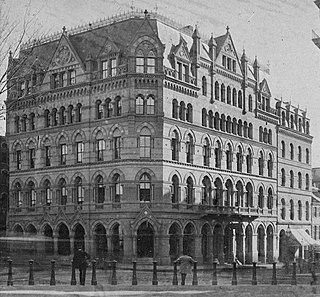
Hotel Boylston (1871-1894) of Boston, Massachusetts, stood at the corner of Tremont Street and Boylston Street in today's Boston Theater District. The architecture firm of Cummings and Sears designed it "in the Italian-Gothic style" as a residential apartment building. Among the tenants: New England Kennel Club; Christian Science Publishing Co.; and piano dealer Steinert & Sons and its 350-seat concert hall.

The Boston Evening Traveller (1845–1967) was a newspaper published in Boston, Massachusetts. It came out daily, with weekly and semi-weekly editions, under a variety of Traveller titles. It was absorbed by the Boston Herald in 1912, and ceased publication in 1967.
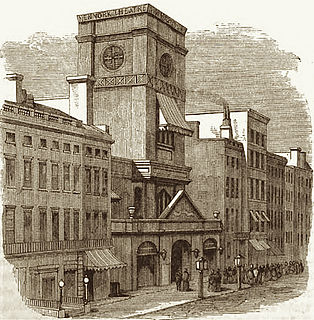
The Church of the Messiah at 728–30 Broadway, near Waverly Place in Greenwich Village, Manhattan, New York City, was dedicated in 1839 and operated as a church until 1864. In January 1865 it was sold to department store magnate Alexander Turney Stewart and converted into a theater, which subsequently operated under a series of names, including Globe Theatre, and ending with New Theatre Comique. It burned down in 1884.
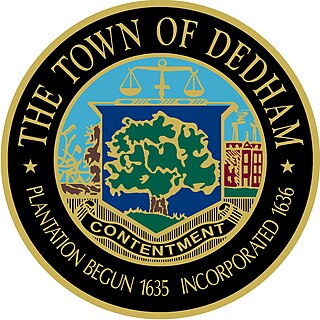
Rev. Dennis J. O'Donovan was an American Roman Catholic priest.









